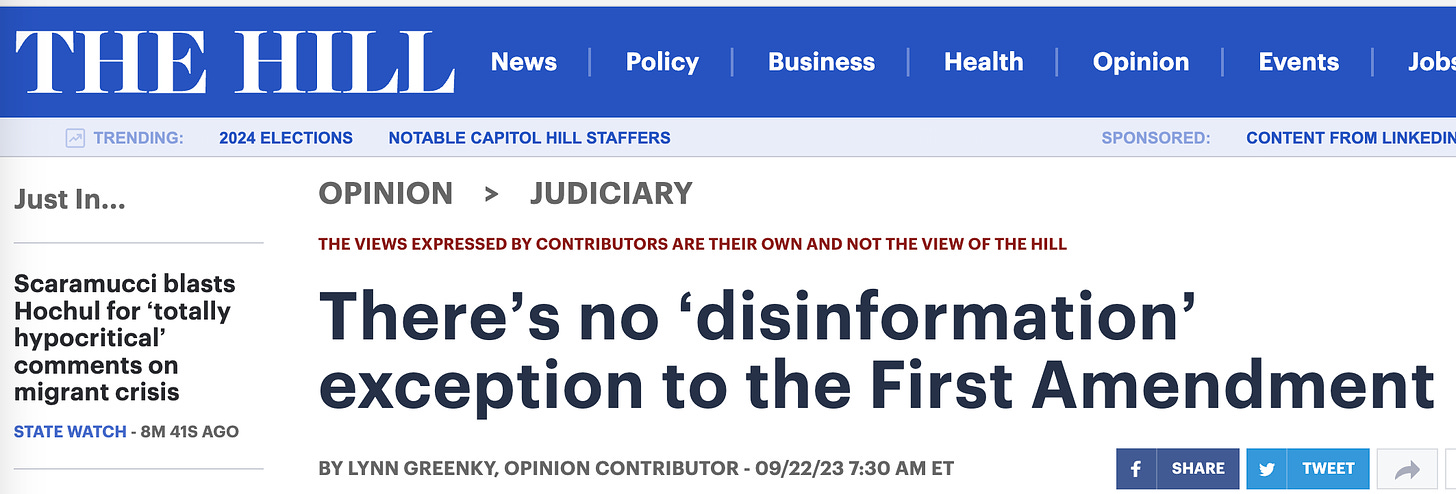by Robert Malone MD MS, Who Is Robert Malone:
 Creating cognitive dissonance is a tool to control the masses
Creating cognitive dissonance is a tool to control the masses
How they program your mind…
Let’s examine a recent article relating to an important news story. That story being that the Supreme Court has stayed the injunction until Sept 22nd of the Missouri v. Biden case. The injunction resulted from a lawsuit filed by the attorneys general of Missouri and Louisiana.
TRUTH LIVES on at https://sgtreport.tv/
To refresh, the Biden administration appealed yet another loss involving the Missouri v. Biden decision, after both the Fifth Circuit Court of Appeals and a lower court found that the administration had colluded with Big Tech/social media companies, such as Twitter (X) to censor Americans- a breach of the first amendment.
In theory, as Sept. 22nd has come and gone, this seems to imply that the injunction is now back in place, but there has been no direct coverage of this issue in corporate media. Which in turn implies that there has been no statement on this by the Supreme Court or discussion in the official SCOTUS blog.
However, we have had a proactive strike by “The Hill” relating to this topic.

The title of the article, “There’s no “disinformation” exception to the First Amendment” is strong. That is…what we all want to hear – censorship is bad!
Misinformation and disinformation retain the basic characteristics of speech. Unless they fall into one of very few exceptions, they are protected from censorship under the First Amendment.
Consistent with those very limited exceptions, any effort by the government to prevent the dissemination of ideas or opinions, even if they are based on untruths, is unconstitutional.
A three-judge panel for the Fifth Circuit Court of Appeals recently upheld an injunction that prohibits the government from pressuring social media platforms to de-escalate or remove speech that the government identifies as misinformation or disinformation.
On Thursday, Sept. 14, that injunction was put on pause by the Supreme Court until Sept. 22, to give the Court more time to consider the issue.
This all sounds just what we want to read, right? But then ever so slowly, the essay redefines what is free speech and ends with this:
Although the government may not be able to silence disinformation, it remains free to publish its own messages and to debate, even disparage, its critics. It can also engage, in all matters of persuasion, to encourage social media platforms to publish only those messages that support government-approved points of view.
Additionally, there are legislative options. The government can remove the immunity protections provided to social media platforms by section 230 of the Communication Decency Act. With immunity protections removed, social media companies would risk liability for harms directly related to hosted messages. They might then be motivated to create stronger content moderation policies and police them more carefully.
If, despite all best efforts, disinformation continues to infect the marketplace of ideas, then our First Amendment jurisprudence clearly holds that that is the price of our right to speak freely.
Another big hint that this article is not what it seems is that the title of the court case is “Missouri v. Biden”. Yet, somehow the article does not mention President Biden’s name once. Not once. Instead, this is as close as it gets to naming the plaintiffs: “The White House, the CDC, the FBI and the surgeon general”. Note the sleight of hand. This is the name of the case. Biden’s name is listed first on most case documents – yet the article, which has been distributed to the likes of “Real Clear Politics” and other big news aggregators, manages to not use Biden’s name once in the entire essay!

Be careful of articles like this – it starts out strong (of course, everyone believes in free speech), but in the end supports the government’s actions to censor as well as engage in propaganda.
This article uses a form of neural linguistic programming. Designed to both get you to “buy in” to the article by supporting “first amendment rights”, only to then turn the tables to write that government has a right to harass social media platforms into censoring for them. The messaging is then distributed to many news channels and the lede is repeated again and again. Which is a seemingly positive message – who doesn’t believe in free speech, right? If you buy into their twisted logic, you will have fallen deep into cognitive dissonance territory – and this is the intention.
Read More @ rwmalonemd.substack.com




